The backdrop
- American Revolution—fight against governing without representation.
- American Revolutionary War (1775-1783).
- Oppressive economic condition.
- Post war economic instability.
- Demands of European war investors.
- Heavy taxes imposed to repay debt of war.
- Rural people worst hit.
The British Empire governed thirteen colonies in North America, without local representation.
In the latter half of the 18th century there was an emergence of republican thought; about liberty, freedom and sovereignty. These ideals also talked about ‘inalienable rights’ which cannot be taken away by majority voting (thus differing from democracy).
National governance was till now according to the Articles of Confederation, which did not ensure these rights and was a weak document.
This led to the American Revolution, which culminated in a war that overthrew the British mnarchy and led to a sovereign U.S.
There was a huge national debt after the American revolution, some that was owed to European alliances like France, and the rest was to Americans who had provided troops food, animals and supplies.
To repay the huge debt of war, heavy taxes were imposed on the locals especially rural farmers to pay back the European partners in the Revolution who were demanding payment in precious metals.
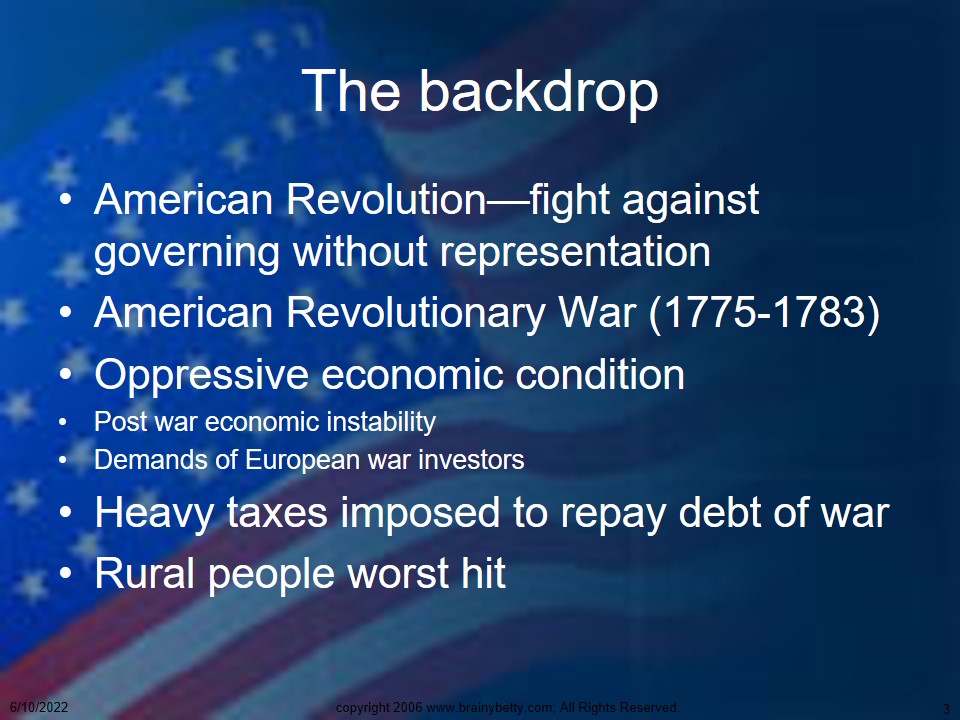
People in distress
- Veterans:
- Forced drafting into the Continental Army.
- No pay during their services.
- Imprisoned if not able to pay standing dues after discharge.
- Rural people/farmers:
- Forced to sell cattle, farmland etc. to pay taxes.
- Property including houses confiscated if unable to pay.
The Continental Armies were formed from the thirteen colonies to resist and fight British rule. General George Washington was appointed as its commander.
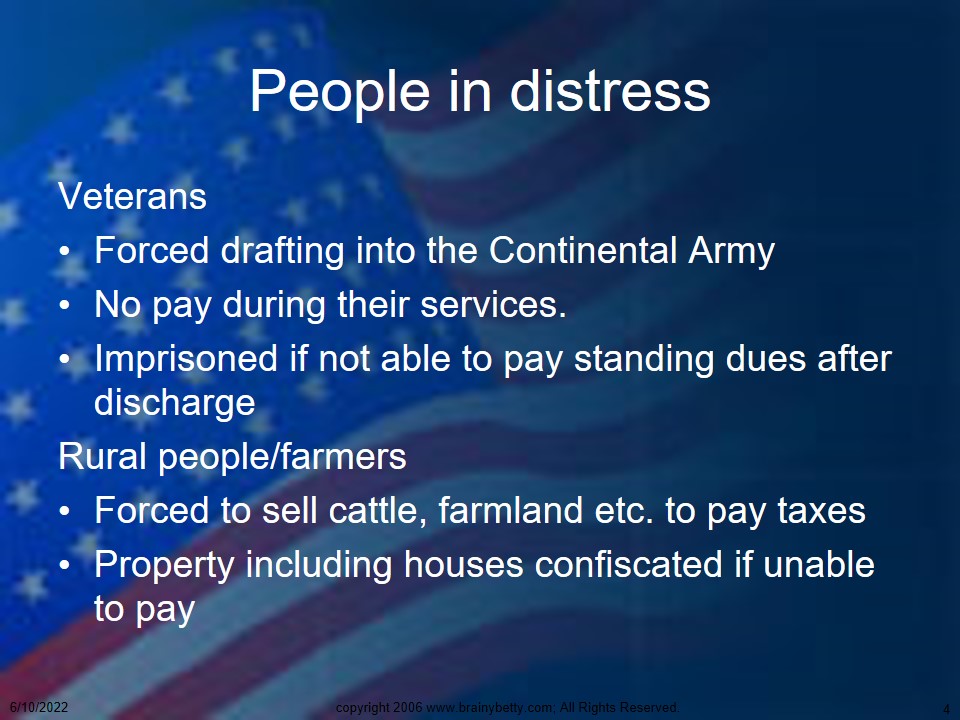
Daniel Shay
- Born: 1741.
- Place of Birth: Massachusetts, U.S.
- Family: Father emigrated from Ireland.
- Early life: worked as a farm laborer.
- Married in 1772 to Abigail Gilbert in Mass.
The year 1741 is the probable year of birth. He was the second of six children.
He did not receive any formal education. He was considered smart and paid more than the going rate for his farm work. Even then, he had a flair for military work.
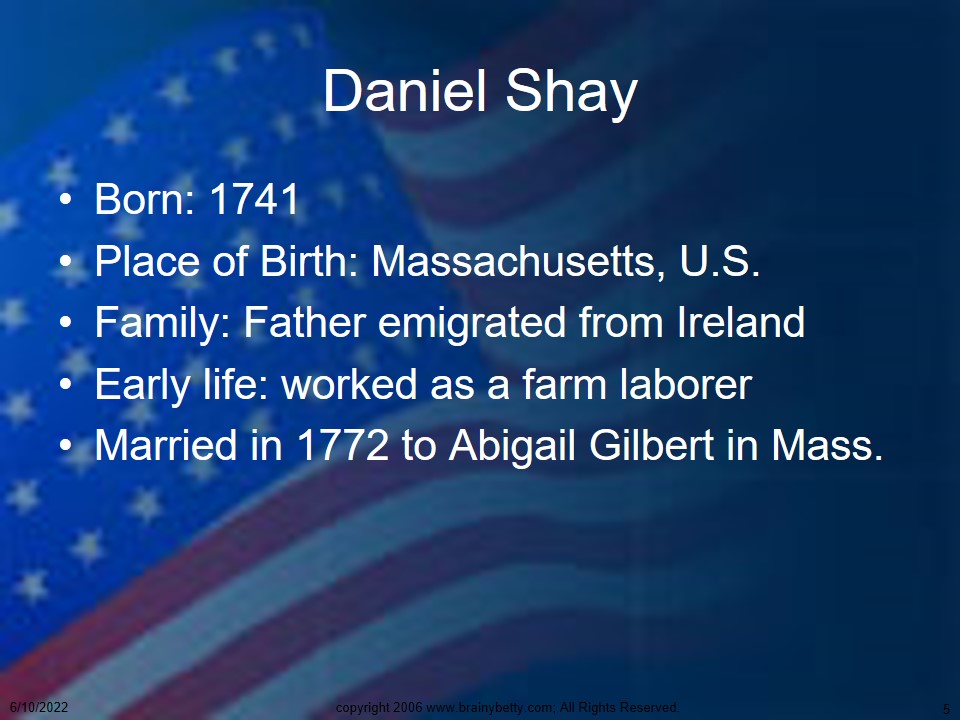
Army Days
- Joined the continental army at the start of the Revolution.
- Rose to the position of captain in a regiment.
- Reputation as courageous and competent officer.
- Honored by General Lafayette with a ceremonial sword for his services.
- Making ends meet on his paltry pay was difficult and he had to sell his sword.
- Resigned from the army in 1780 and went back to Mass.
- Shays was elected to the local county.
- Due to the post war recession, he was forced to sell off big parts of his land.
- The local county did not implement the debtor relief reforms.
- Dissent and frustration grew and Shay joined the rebels.
The local county held conventions where the plight of the farmers was presented and petitions drawn to relieve their troubles, but these were not very effective in addressing their troubles.
Those veterans and farmers who had been imprisoned for non-payment of taxes and dues gathered people who were similarly affected and organised them into units of rebels.
The Massachusetts Legislature was bent on paying off the war debt by forcing money from the locals, and this angered and brought together thousands of men who had no hard money to offer but only livestock and farmland
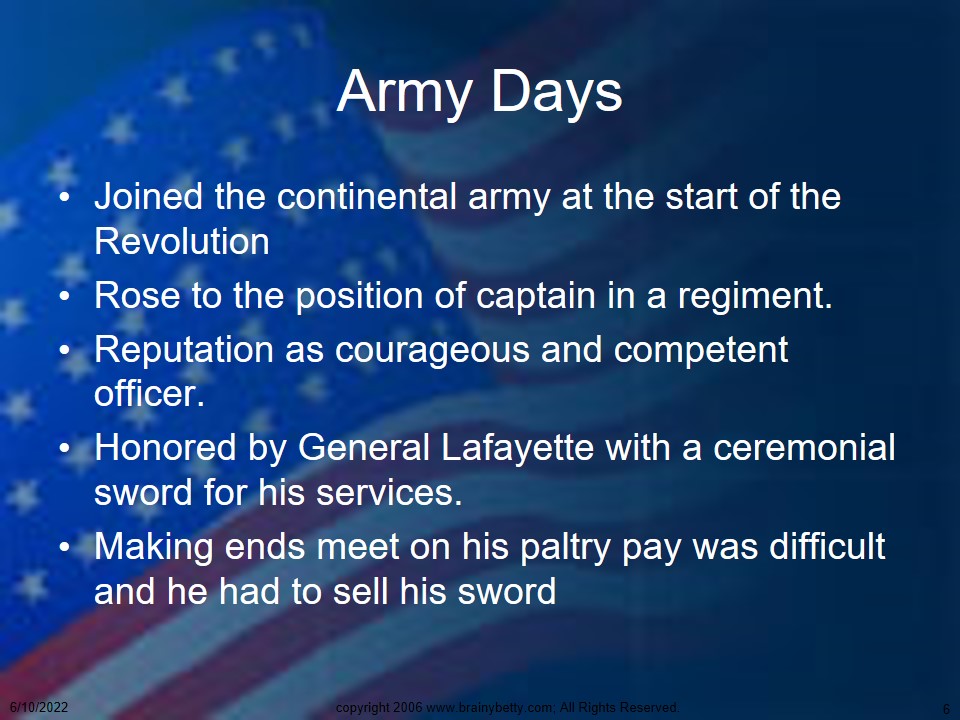
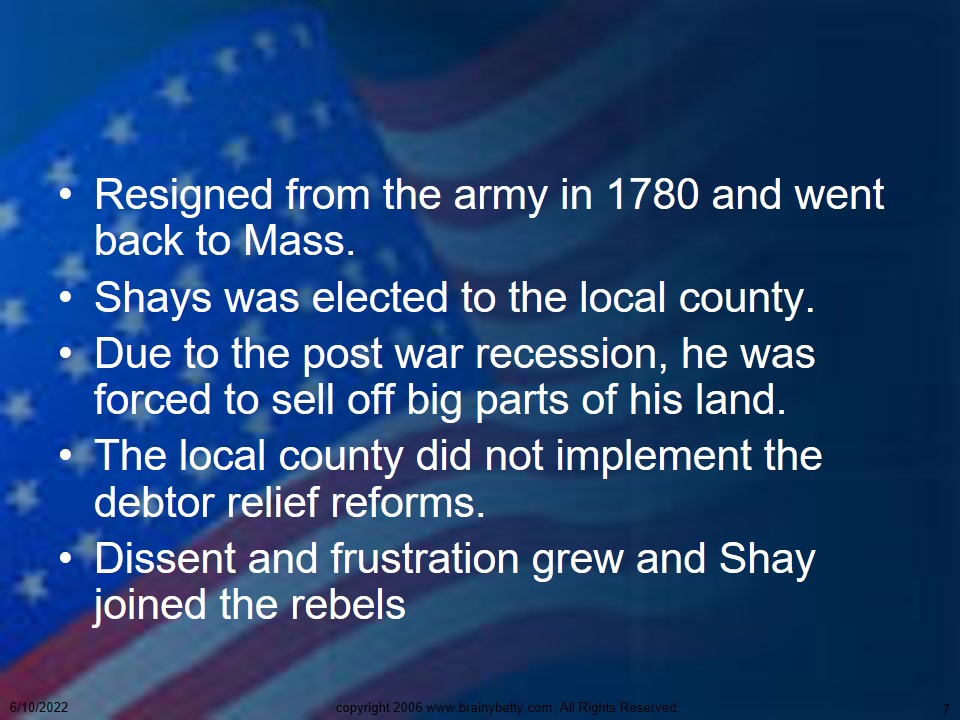
The dissent
- The rebels were unarmed poor locals.
- The initial aim of the rebellion was to stop the court rulings against local debtors.
- Judges were continuously ruling against the locals—taking away their farms and houses, and imprisoning them when nothing was left.
- The elite of the area were unsympathetic and the Mass. Governor worked to ‘vindicate the insulted dignity of government’.
- Shays saw himself as a mediator between the rebels (Regulators) and the government.
- However, the government came to see him as a growing threat and leader of the whole rebellion.
- Shays eventually lead the largest group of insurgents.
- Springfield, January—Shay’s Rebellion—encounter with militia.
- First casualties and many wounded—most of the rest captured a month later.
Initially, the rebels used to gather outside courthouses to prevent judges from pronouncing verdicts aginst defaulting locals.
The encounter at Springfield between 1200 men under Shay and the militia gave this uprising the name of ‘Shay’s Rebellion’. It was an attempt to take over the Federal arsenal, but was made unsuccessful by the militia which fired canons at the rebels and killed four, injured many.
Although eventually Shay came to lead the biggest insurgency, he has been described as a ‘reluctant leader’ and always declared that his intention was to bring about a peaceful resolution to the conflict.
His support for the rebels was intended to strengthen their position against the government. The attempt to take over the Federal arsenal was directed at improving their negotiating position with the government by providing arms.
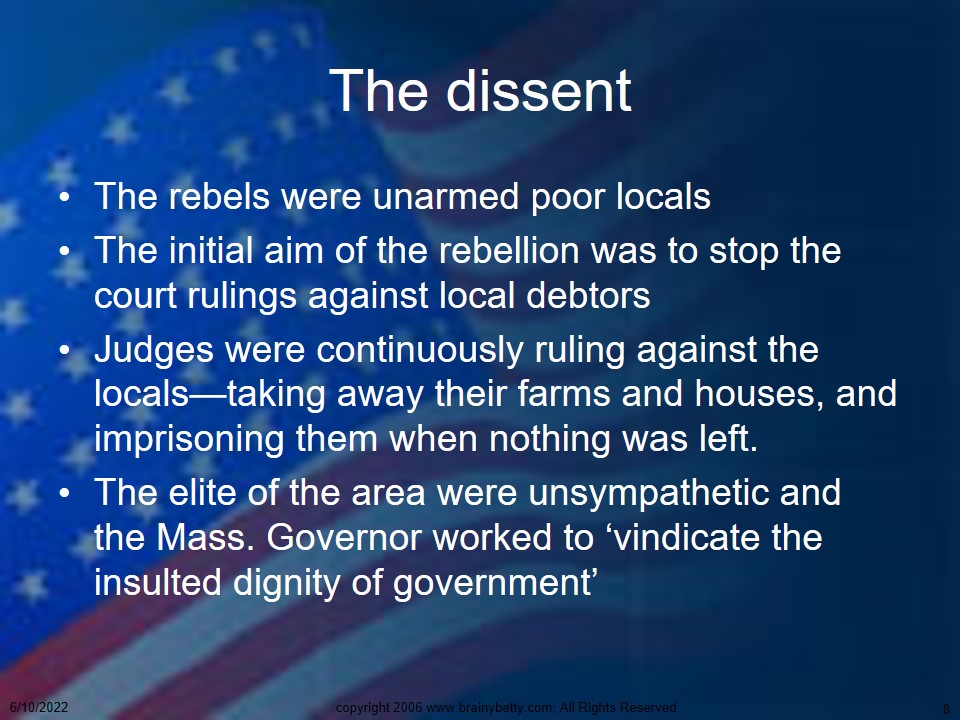
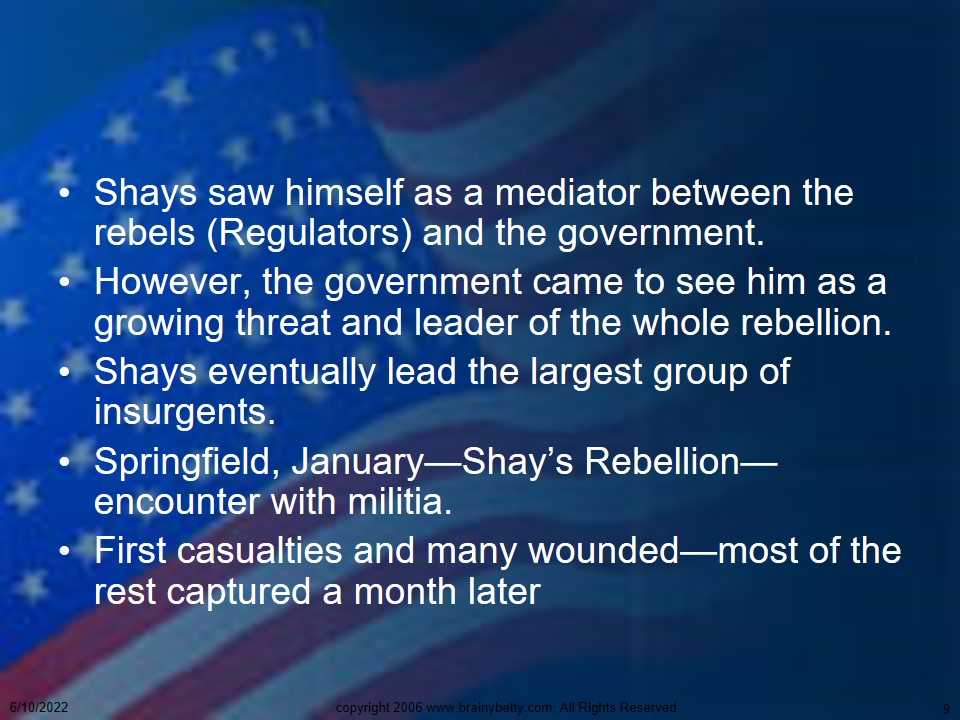
The aftermath
- Some rebels, including Shay, fled the state.
- By the end of Feb of that year, the rebellion was over.
- In his absence, Shay was sentenced o death for what the court saw as treason.
- The rebels and Shay were eventually pardoned.
- Shay lived in New York till his death in 1825.
Shay appealed for amnesty against his sentence and was granted pardon. After he moved to New York, he was even granted monthly pension in recognition of his commendable services during the Revolutionary War.

Daniel Shay in history
- Daniel Shay has been called by some historians as a ‘misguided leader of a hapless rebellion against authority’.
- A monuments erected to mark his endeavors warns that ‘Obedience to Law is True Liberty’ but a newer one reads: ‘True Liberty and Justice may require resistance to law’.
- Others consider him as a revolutionary.
- The places where he lived and hid have been named after him.
- Several book have been written, based on his character, that portray him in a positive light.
- Sprigs of Hemlock, by Walter Dwyer 1931;
- The Winter Hero, by Christopher Collier 1978;
- A Boston music band calls itself ‘Shay’s Rebellion’;
- Shay’s Street and Shay’s Highway, his routes.
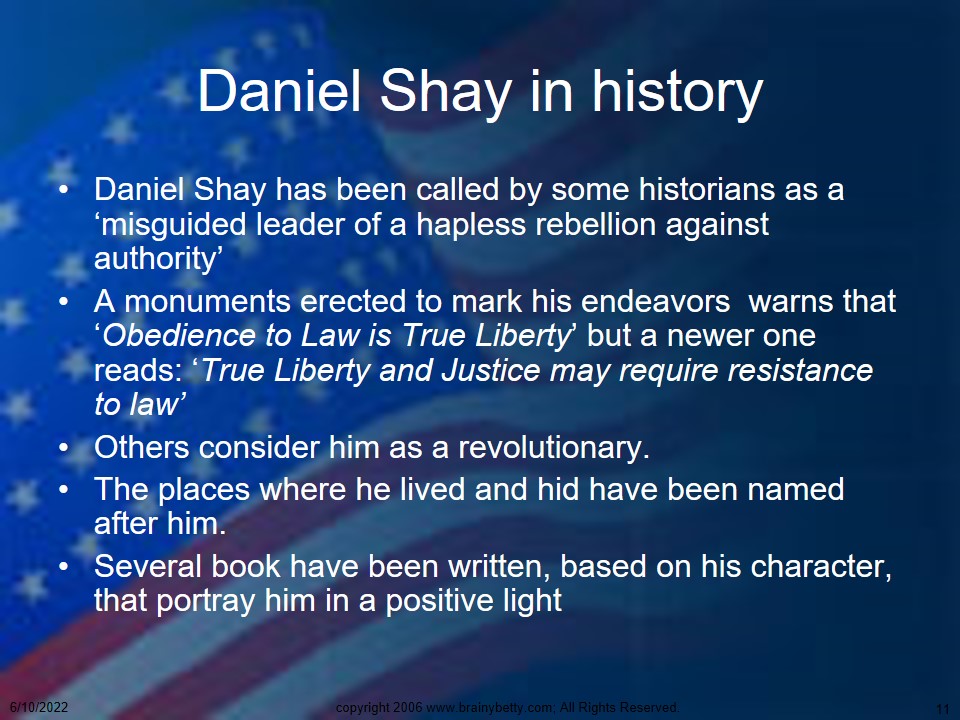
His legacy
- The Rebellion played a major part towards the drawing up of the United Nation’s Constitution.
- The thirteen colonies had hitherto never worked for a strong central government as they were suspicious of the British.
- After achieving sovereignty Americans recognized the need for a strong centre that would address local issues as it would have local representatives.
- Representative from all states realised that the Article of Confederation was very flawed.
- The Constitutional Convention sat in 1787 to draft a new constitution.
Through their endeavors, Shay and his men raised fundamental questions about the responsibility of the government towards its citizens and the accountability of those in power.
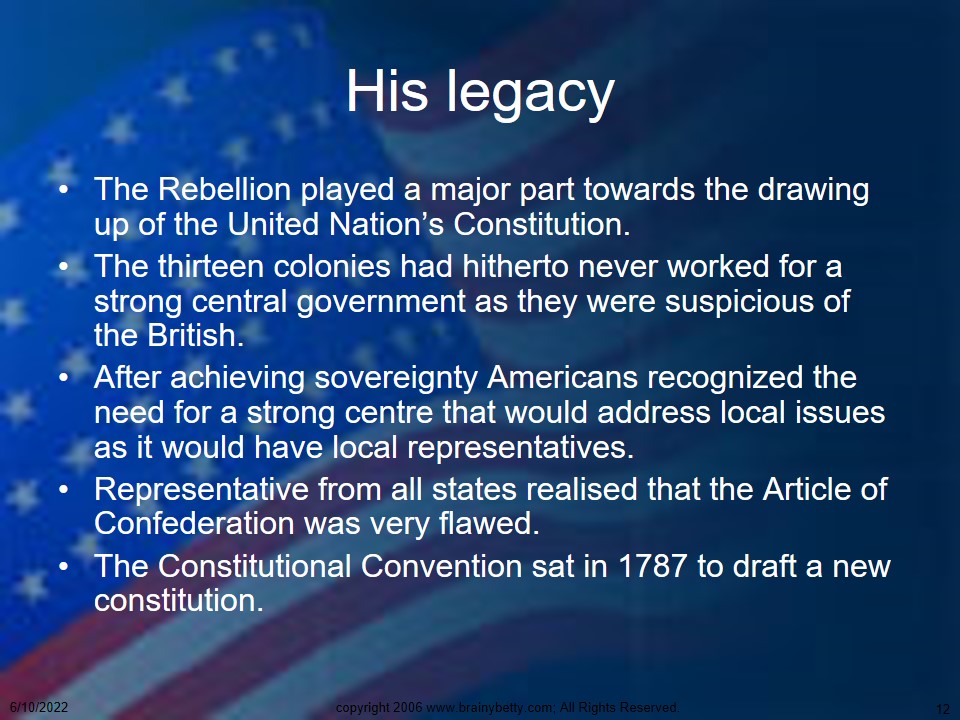
The American Constitution
- The aim was to form a more stable union by curbing the power of the state and giving more rights to the people, to prevent insurgencies like Shay’s Rebellion.
- Instead a strong federal government would keep a check on state legislatures and prevent them from acting the way they did in Massachusetts.
- The resulting document took away all sovereign power from state republics.
- It remained for the locals to accept or reject this new proposal, specially in Mass., where people had become wary of any sort of authority.
- However, in 1788 the Mass convention ratified the new Federal Constitution.
- Thus the U.S. emerged from its critical period.
- The turmoil of trying to relate to a central government took new form.
- Throwing off the monarchy and establishing republican forums.
- Dealing with internal dissent and the issues of the locals.
- Realizing that the principles behind the revolution were not just to rid the country of a foreign power, but to have a government that works for the people of the country.
A few state representatives, however, disagreed, and thought that curbing the state’s autonomy and power would make it more vulnerable to uprisings.
Thus the rebellion changed the concept of governance. From the British policy of ‘divide and rule’—making a weak constitution (Articles of Federation) so that the states could not unite against the British, the Americans worked towards a policy of unity, liberty and civil rights.
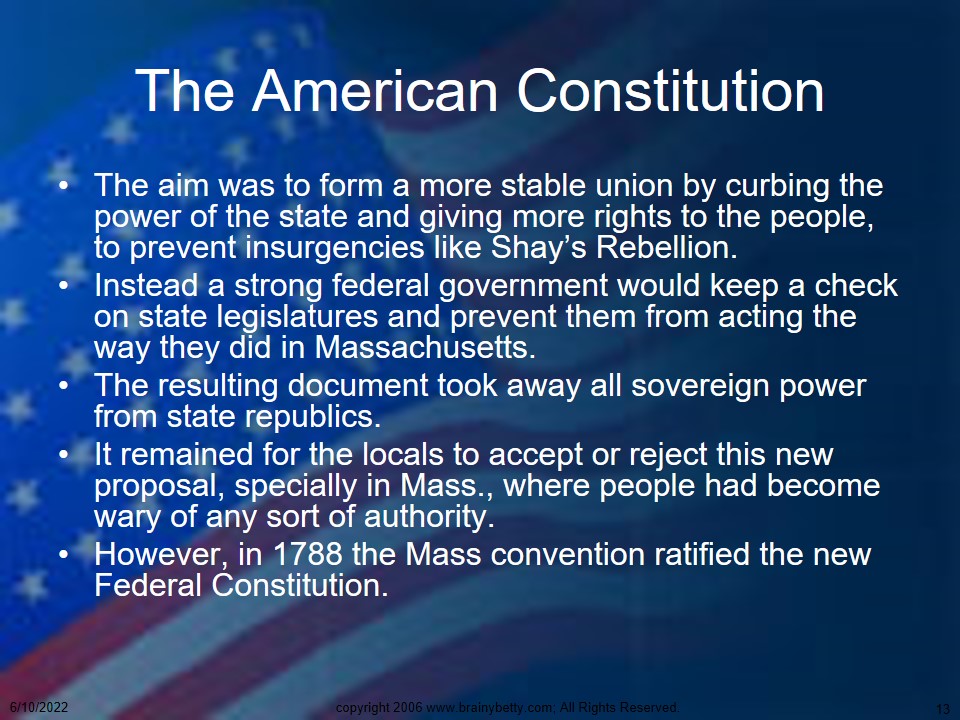
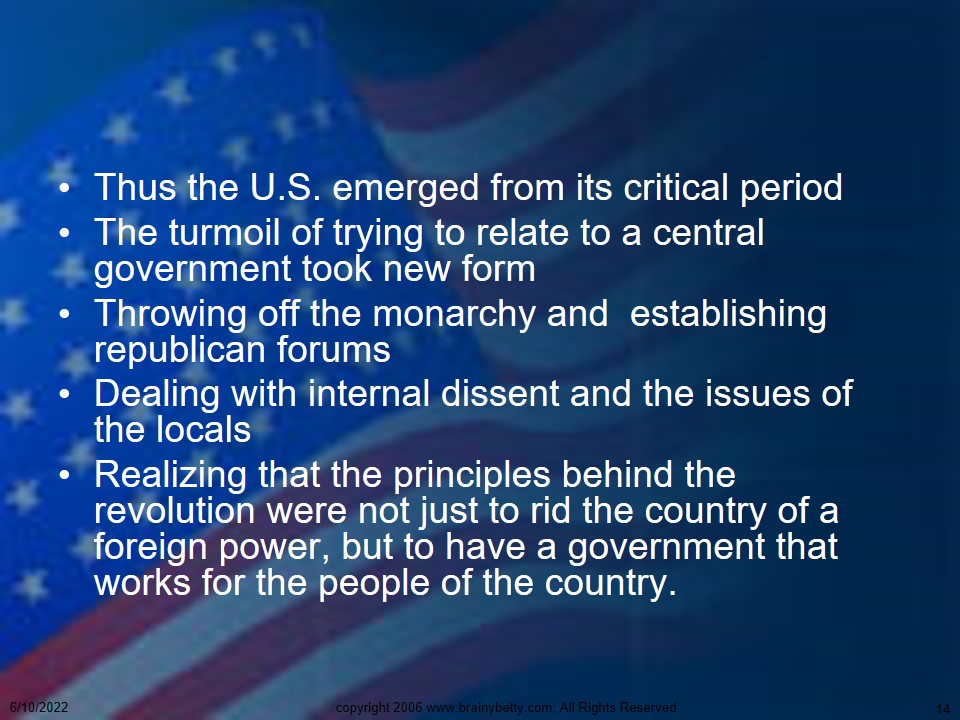
References
“Daniel Shays Biography.” A People’s History of the United States. 2005.
“People: Daniel Shays”. Massachussettes 2008. Ed. Sprigfield Technical Community College. Web.
Szatmary, David P. Shays’ Rebellion : The Making of an Agrarian Insurrection. Amherst: University of Massachusetts Press, 1980.
Zinn, Howard. A People’s History of the United States : 1492-Present. Rev. and updated ed. New York: HarperPerennial, 1995.